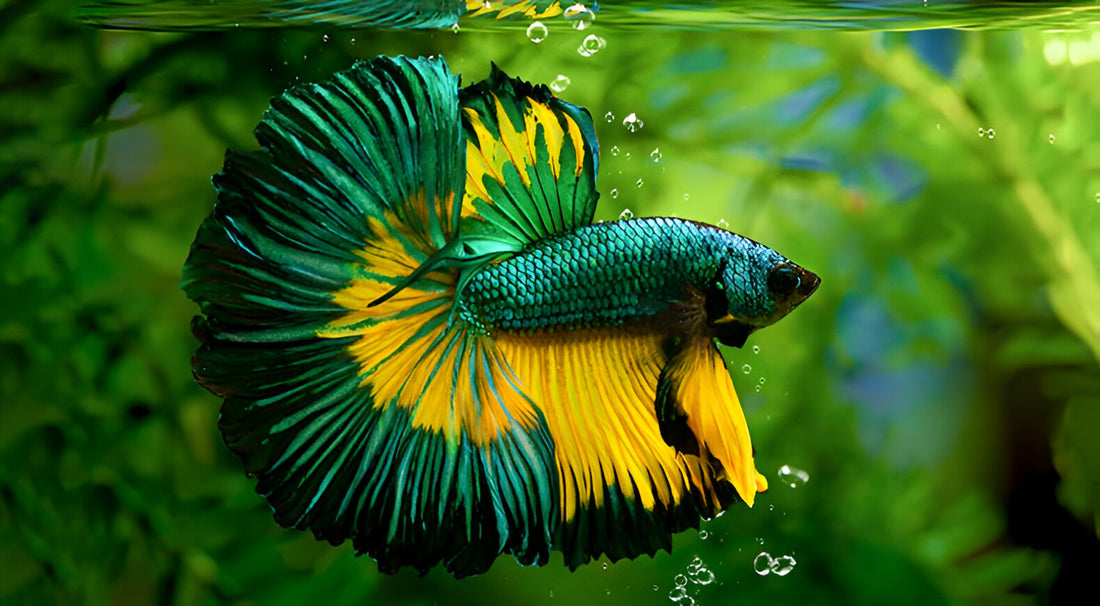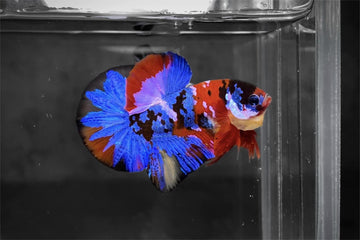Top 10 Fascinating Betta Fish Facts Every Owner Should Know

Contents
Betta fish, also known as Siamese fighting fish, are captivating creatures that grace aquariums with their vibrant colors and unique personalities. Whether you’re a seasoned betta owner or considering bringing one home, here are ten intriguing facts about these aquatic gems:
Fact 1: Betta Fish Can Breathe Air
Unlike most fish that rely solely on gills for oxygen, betta fish possess an extraordinary adaptation that sets them apart. These remarkable creatures have the ability to breathe not only underwater but also at the water's surface.
Bettas owe this unique capability to an organ called the labyrinth, located behind their heads. This specialized organ functions much like a lung, allowing them to gulp air from above the water. So, when you see a betta rising to the water’s surface and taking a gulp of air, it’s their clever way of supplementing their oxygen intake.

This helps bettas survive in oxygen-deprived environments such as shallow ponds, rice paddies, and stagnant waters, where many other fish species might struggle.
This unique ability allows them to thrive in environments where other fish might struggle. They can even hunt insects that reside outside the water, providing them with an additional food source in smaller or more competitive ecosystems.
WARNING: Your betta could live out of water, briefly. But that does not mean you should take them out frequently or let children hold them.
Fact 2: Betta Fish Love Protein
Betta fish are known to nibble on everything, but their primary diet should revolve around protein-rich foods to maintain their health and vibrancy.
In their natural environment, bettas are insectivores, feasting mainly on insects and their larvae. We can replicate this diet using high-quality betta pellets designed to meet their nutritional requirements.
Additionally, they’ll relish live or frozen treats like:
- Bloodworm
- Brine shrimp
- Daphnia
- Mosquito larvae
- Blackworm
Remember to feed your betta fish in moderation—usually twice a day—and promptly remove any uneaten food to prevent water quality issues. A varied diet not only keeps them physically fit but also mentally engaged, reducing the risk of boredom and related behavioral problems.
Fact 3: Male Bettas Are Territorial Warriors
Male bettas are true warriors when it comes to defending their territory. This aggressive behavior is hardwired into their genes from living in the wild. In their natural habitats, these flashy fish stake out their own turf and fiercely guard it - this allows them access to food, shelter, and potential mates.

Even in home aquariums, that territorial instinct kicks in full force. If you house two male bettas together, be prepared for some serious fights to break out. These underwater battles can lead to torn fins, bite injuries, and even deaths. That's why pet stores and fishkeepers separate males into their own tanks.
If you plan to keep multiple males, each should have its own tank or be introduced simultaneously to a divided tank to minimize aggression. Providing plenty of plants and hiding spots can also help reduce stress and mimic their natural environment.
Fact 4: Female Bettas Can Live in Sororities
While males are the famously aggressive fighters, female bettas can get along swimmingly when kept together in a sorority. The ladies tend to be a bit less territorial and hostile than the gents.
To set up a successful betta sorority tank, you'll want at least five females with a decent-sized tank that gives each girl a minimum of one gallon of her own space. Providing plenty of plants, caves, and hidey-holes is key - this lets each queen stake out her corner territory and reduces conflicts over prime real estate.
There'll likely be some spats and flaring as they establish their ranking at first. But once the pecking order gets sorted out, the squabbles should settle down into an accepting, chilled-out sorority vibe. Just keep an eye out for any single female getting incessantly picked on by the others.
A sorority can turn into an incredibly vibrant display with the right accommodations. You can witness the unique personalities and interactions between these vividly colored underwater beauties!
Fact 5: Male Bettas Build Bubble Nests
One of the coolest behaviors you'll see from male bettas is when they blow those wacky little bubble nests! The males make these fishy apartment complexes using a mixture of saliva and air bubbles along the water's surface.

Out in their natural habitats, these frothy nests serve as a nursery for eggs and baby fish fry during breeding season. But even when there's no female around, a healthy, happy male betta will often blow bubble homes just for fun. It's their way of showing they're in perfect baby-making shape!
If your male starts blowing bubbles, consider it a good sign about his well-being. For betta breeders, getting the water nice and warm with very little disturbance helps encourage this nest-building behavior.
Whether you have breeding plans or not, spotting a new bubble nest is a great indicator that your vividly colored little betta is feeling content in his home!
Fact 6: Bettas Come in a Rainbow of Colors
Bettas are renowned for their stunning rainbow of colors and patterns. From bold blues to radiant reds, their coloration is determined by a variety of genes like Koi, Nemo, and Marble Genes.

But it's not just genetics – pigments in their scales also play a big role. Depending on their environment and health, these pigments react to light, making a betta's colors appear more intense or faded.
Interestingly, a betta's color can change based on several factors like their mood, health, and surroundings. Stress, poor water quality, or an inadequate diet can lead to dull colors, while optimal conditions enhance their brilliance.
Fact 7: Bettas Are Excellent Jumpers
Don't be fooled by their small size – bettas are impressive jumpers! In the wild, this skill helps them navigate between small bodies of water and catch prey.
However, in a home aquarium, their jumping abilities can be a cause for concern if the tank isn't properly covered. These curious fish may leap out in search of food or during territorial disputes, which could lead to accidents.
To keep your betta safe, make sure to have a secure lid and avoid overfilling the tank. Providing plenty of plants, caves, and other enrichment can also help reduce jumping by keeping them engaged and content in their watery home.
Fact 8: Bettas Thrive in Shallow Waters
Bettas naturally thrive in the shallow, slow-moving waters of Southeast Asia like streams, rice paddies, and marshes. Recreating this natural shallow water habitat is key for keeping bettas healthy in captivity.
Here is how you can do it:
- Provide a shallow tank that allows access to the surface for air breathing.
- A minimum of 5 gallons is recommended for the tank size.
- Keep the water level around 10-12 inches.
- Incorporate live or silk plants and decorations for hiding spots and security.
- Use a gentle filter, like a sponge filter, to avoid strong currents.
- Maintain a temperature of 76-82°F (24-28°C) and a pH level between 6.5 and 7.5, and perform 25% weekly water changes.
- Provide moderate lighting to support plant growth and keep the tank well-lit.
By replicating the conditions of their wild environments, you can ensure your betta fish lives a healthy, stress-free life.
Fact 9: Bettas Recognize Their Owners
Betta fish possess an extraordinary talent: they can recognize their caretakers. Bettas mostly associate their owners with food and playtimes, so the more you interact with your betta fish, the more likely they'll recognize you.
This recognition is a sign of their intelligence and ability to form bonds. Through regular interaction, these little aquatic companions become familiar with the presence of their owners. You might even catch them swimming to the front of their tank or flaring their delicate fins in greeting.
Fact 10: Bettas Are Named After Warriors
The name “betta” has its roots in an ancient Southeast Asian clan of warriors known as the “Bettah” These warriors were renowned for their courage and combat skills. Fittingly, bettas seem to embody that same indomitable warrior spirit - they are incredibly territorial and resilient little fighters.

Bettas were historically pitted against each other in organized fighting competitions that showcased their aggressive natures. While this practice is now discouraged and even illegal in many places, bettas still carry on the legacy of their formidable fighter ancestors. This rich cultural backstory adds to the fascination of keeping these fish, making them colorful pets and living emblems of strength.
Their warrior namesakes give bettas an air of mystique beyond just their brilliant beauty. Owning one of these feisty fish connects you to an age-old tradition celebrating fortitude and prowess in the smallest of packages.
No comments











0 comments